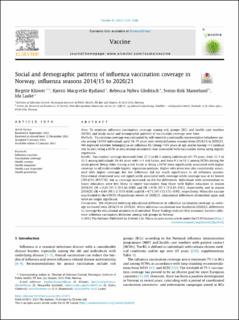| dc.contributor.author | Klüwer, Birgitte | |
| dc.contributor.author | Rydland, Kjersti Margrethe | |
| dc.contributor.author | Gleditsch, Rebecca | |
| dc.contributor.author | Mamelund, Svenn-Erik | |
| dc.contributor.author | Laake, Ida | |
| dc.date.accessioned | 2023-05-11T07:39:19Z | |
| dc.date.available | 2023-05-11T07:39:19Z | |
| dc.date.created | 2023-01-13T14:51:28Z | |
| dc.date.issued | 2023 | |
| dc.identifier.citation | Vaccine. 2023, 41 (6), 1239-1246. | en_US |
| dc.identifier.issn | 0264-410X | |
| dc.identifier.uri | https://hdl.handle.net/11250/3067584 | |
| dc.description.abstract | Aims: To examine influenza vaccination coverage among risk groups (RG) and health care workers (HCW), and study social and demographic patterns of vaccination coverage over time. Methods: Vaccination coverage was estimated by self-report in a nationally representative telephone survey among 14 919 individuals aged 18–79 years over seven influenza seasons from 2014/15 to 2020/21. We explored whether belonging to an influenza RG (being >=65 years of age and/or having >=1 medical risk factor), being a HCW or educational attainment was associated with vaccination status using logistic regression.
Results: Vaccination coverage increased from 27 % to 66 % among individuals 65–79 years, from 13 % to 33 % among individuals 18–64 years with >=1 risk factor, and from 9 % to 51 % among HCWs during the study period. Being older, having a risk factor or being a HCW were significantly associated with higher coverage in all multivariable logistic regression analyses. Higher education was also consistently associated with higher coverage, but the difference did not reach significance in all influenza seasons. Educational attainment was not significantly associated with coverage while coverage was at its lowest (2014/15–2017/18), but as coverage increased, so did the differences. Individuals with intermediate or lower education were less likely to report vaccination than those with higher education in season 2018/19, OR = 0.61 (95 % CI 0.46–0.80) and OR = 0.58 (95 % CI 0.41–0.83), respectively, and in season 2019/20, OR = 0.69 (95 % CI 0.55–0.88) and OR = 0.71 (95 % CI 0.53–0.95), respectively. When the vaccine was funded in the COVID-19 pandemic winter of 2020/21, educational differences diminished again and were no longer significant.
Conclusions: We observed widening educational differences in influenza vaccination coverage as coverage increased from 2014/15 to 2019/20. When influenza vaccination was funded in 2020/21, differences in coverage by educational attainment diminished. These findings indicate that economic barriers influence influenza vaccination decisions among risk groups in Norway | en_US |
| dc.language.iso | eng | en_US |
| dc.publisher | Springer | en_US |
| dc.relation.ispartofseries | Vaccine; | |
| dc.relation.uri | https://doi.org/10.1016/j.vaccine.2023.01.013 | |
| dc.rights | Navngivelse 4.0 Internasjonal | * |
| dc.rights.uri | http://creativecommons.org/licenses/by/4.0/deed.no | * |
| dc.title | Social and demographic patterns of influenza vaccination coverage in Norway, influenza seasons 2014/15 to 2020/21 | en_US |
| dc.type | Peer reviewed | en_US |
| dc.type | Journal article | en_US |
| dc.description.version | publishedVersion | en_US |
| cristin.ispublished | true | |
| cristin.fulltext | original | |
| cristin.qualitycode | 1 | |
| dc.identifier.doi | http://dx.doi.org/10.1016/j.vaccine.2023.01.013 | |
| dc.identifier.cristin | 2106715 | |
| dc.source.journal | Vaccine | en_US |
| dc.source.volume | 41 | en_US |
| dc.source.issue | 6 | en_US |
| dc.source.pagenumber | 1239-1246 | en_US |
| dc.relation.project | Norges forskningsråd: 302336 | en_US |

